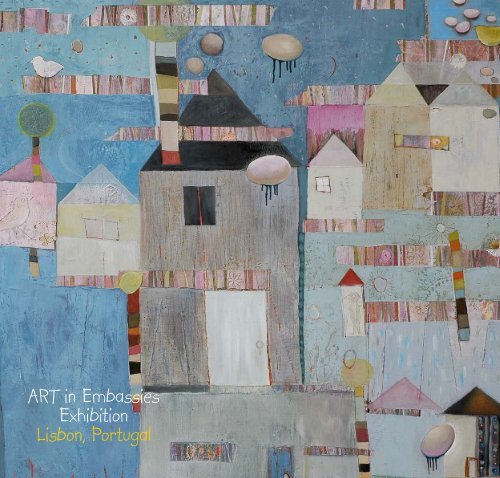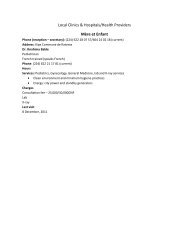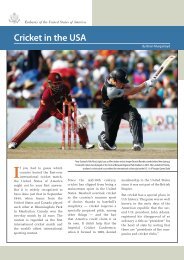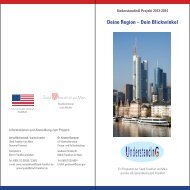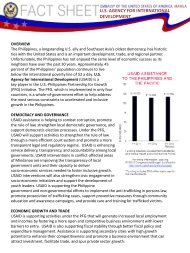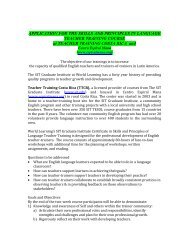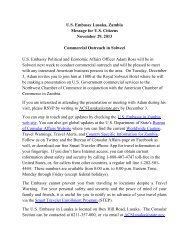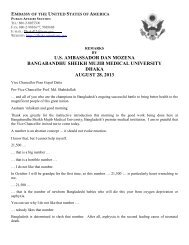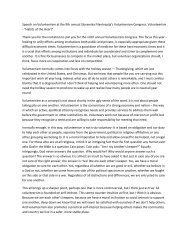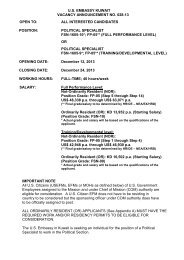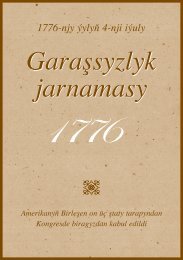Las P - Photo Gallery - US Department of State
Las P - Photo Gallery - US Department of State
Las P - Photo Gallery - US Department of State
You also want an ePaper? Increase the reach of your titles
YUMPU automatically turns print PDFs into web optimized ePapers that Google loves.
ART in Embassies<br />
Exhibition<br />
Lisbon, Portugal
Lorna Teixeira<br />
Degrees <strong>of</strong> Separation, 2008. Oil and wax, 36 x 36 in. Courtesy <strong>of</strong> the artist, San Luis Obispo, California<br />
Degrees <strong>of</strong> Separation, 2008. Óleo e cera, 91,4 x 91,4 cm. Cortesia do Artista, San Luis Obispo, California<br />
ART in Embassies ARTE nas Embaixadas<br />
Established in 1963, the U.S. <strong>Department</strong> <strong>of</strong> <strong>State</strong>’s<br />
<strong>of</strong>fice <strong>of</strong> ART in Embassies (ART) plays a vital role<br />
in our nation’s public diplomacy through a culturally<br />
expansive mission, creating temporary and permanent<br />
exhibitions, artist programming, and publications. The<br />
Museum <strong>of</strong> Modern Art first envisioned this global visual<br />
arts program a decade earlier. In the early 1960s, President<br />
John F. Kennedy formalized it, naming the program’s first<br />
director. Now with over 200 venues, ART curates temporary<br />
and permanent exhibitions for the representational spaces<br />
<strong>of</strong> all U.S. chanceries, consulates, and chief-<strong>of</strong>-mission<br />
residences worldwide, commissioning and selecting contemporary<br />
art from the U.S. and the host countries. These<br />
exhibitions provide international audiences with a sense <strong>of</strong><br />
the quality, scope, and diversity <strong>of</strong> both countries’ art and<br />
culture, establishing ART’s presence in more countries than<br />
any other U.S. foundation or arts organization.<br />
ART’s exhibitions allow foreign citizens, many <strong>of</strong> whom<br />
might never travel to the United <strong>State</strong>s, to personally experience<br />
the depth and breadth <strong>of</strong> our artistic heritage and values,<br />
making what has been called a: ‘’footprint that can be<br />
left where people have no opportunity to see American art.’’<br />
“The ART in Embassies program reveals the rich history and<br />
cultural heritage <strong>of</strong> the United <strong>State</strong>s and the communal<br />
experiences that we share with peoples <strong>of</strong> different countries,<br />
backgrounds and faiths, binding us closer together.<br />
Through its temporary exhibitions and permanent collections,<br />
the ART in Embassies program intrigues, educates,<br />
and connects – playing an ambassadorial role as important<br />
as that served by traditional diplomacy.”<br />
— Hillary Rodham Clinton<br />
Secretary <strong>of</strong> <strong>State</strong><br />
1<br />
Estabelecido em 1963, o gabinete do Departamento de Estado<br />
responsável pelo programa ARTE nas Embaixadas (ARTE)<br />
desempenha um papel vital na diplomacia pública dos E.U.A.<br />
através de exposições temporárias e permanentes, programação<br />
artística e publicações. Na década de 50, o Museum <strong>of</strong><br />
Modern Art (MOMA) de Nova Iorque, foi quem primeiro concebeu<br />
este programa global de artes visuais. Nos primórdios<br />
da década de 60, o Presidente John F. Kennedy reconheceu<br />
formalmente o programa e nomeou o seu primeiro director.<br />
O programa ARTE encomenda e selecciona arte contemporânea<br />
dos E.U.A. e dos países anfitriões para expor em mais<br />
de 200 espaços públicos das chancelarias, consulados e residências<br />
<strong>of</strong>iciais dos embaixadores norte-americancos. Estas<br />
exposições levam aos públicos internacionais a qualidade,<br />
abrangência e diversidade da arte e cultura de ambos os países,<br />
estabelecendo a presença do programa ARTE junto de<br />
mais nações do que qualquer outra fundação ou organização<br />
artística norte-americana.<br />
As exposições do programa ARTE permitem que cidadãos estrangeiros<br />
– muitos dos quais podem nunca visitar os Estados<br />
Unidos – sintam pessoalmente a pr<strong>of</strong>undidade e amplitude<br />
da nossa herança e valores artísticos, dando origem ao que<br />
já foi descrito como “uma impressão que perdura, em locais<br />
onde as pessoas não têm a oportunidade de ver arte norte-<br />
-americana.”<br />
“O programa ARTE nas Embaixadas revela a fascinante<br />
história e herança cultural dos Estados Unidos e a experiência<br />
comunitária que podemos partilhar com povos de<br />
diferentes países, meios e religiões, permitindo uma maior<br />
aproximação. Através das suas exposições temporárias e<br />
colecções permanentes, o programa ARTE nas Embaixadas<br />
cativa, educa, e interliga – desempenhando um papel diplomático<br />
tão importante como o da diplomacia tradicional”.<br />
— Hillary Rodham Clinton<br />
Secretária de Estado dos E.U.A.
Welcome to the Residence <strong>of</strong> the United <strong>State</strong>s Ambassador<br />
in Lisbon. We have the honor <strong>of</strong> living in this historic mansion<br />
built in 1878 by the Count <strong>of</strong> Olivais e Penha Longa. It is a<br />
delightful venue in which to host an ART in Embassies exhibition,<br />
which includes works <strong>of</strong> special significance to our two<br />
nations.<br />
Portugal and the United <strong>State</strong>s <strong>of</strong> America have long shared<br />
a mutually beneficial relationship that goes beyond the diplomatic<br />
sphere and extends to institutional linkages, common<br />
values, and, as this exhibition exemplifies, culture. The<br />
Portuguese-American relationship long predated the <strong>of</strong>ficial<br />
start <strong>of</strong> our formal diplomatic ties in 1791. As the leading<br />
European explorers in the fifteenth century, the Portuguese<br />
discovered and mapped many parts <strong>of</strong> the world for their<br />
homeland, including what is now our west coast state <strong>of</strong><br />
California. Portuguese sailors and fishermen immigrated to<br />
the United <strong>State</strong>s in the early nineteenth century, settling<br />
in Hawaii, California, and New England. Today, America is<br />
proud to count among its citizenry sizable communities <strong>of</strong><br />
Portuguese heritage located in Massachusetts, Rhode Island,<br />
New Jersey, California, and Hawaii, numbering some 1.3 million<br />
individuals.<br />
Based on the historically close ties between the United <strong>State</strong>s<br />
and Portugal, we welcomed the opportunity to select artists<br />
with special ties to Portugal for our ART in Embassies exhibition.<br />
Elements <strong>of</strong> their work contain echoes <strong>of</strong> the rich heritage<br />
<strong>of</strong> both Portuguese and American artistic traditions.<br />
Luso-American painter Elizabeth DaCosta Ahern’s use <strong>of</strong> yellow,<br />
blue, pink, and orange washes are reminiscent <strong>of</strong> the intense<br />
colors that make the Portuguese coastline so thrilling.<br />
The scale <strong>of</strong> her works evokes man’s sense <strong>of</strong> wonder in nature’s<br />
vast presence.<br />
Introduction Introdução<br />
Peter Macara’s mixed media compositions, Black Diamonds<br />
and Beeswax, contain textures and colors that draw on the<br />
Moorish and Portuguese azulejos or tiles that adorn many<br />
building and courtyard walls in Portugal. Often textured and<br />
always colorful, these tiles recall Portugal’s rich and varied artistic<br />
tradition.<br />
Jane Rosen’s use <strong>of</strong> casein and charcoal on wood lends an<br />
ethereal sense <strong>of</strong> depth and mystery to her figures, especially<br />
the raven – enduring symbol <strong>of</strong> the ancient city <strong>of</strong> Lisbon –<br />
who dominates Change <strong>of</strong> Tune, while the somber presences<br />
in Change <strong>of</strong> Coat evoke classical mythology.<br />
Douglas Keats’ series <strong>of</strong> photographs <strong>of</strong> the early churches <strong>of</strong><br />
New Mexico recalls the missions <strong>of</strong> Portugal and Spain, and<br />
the enduring influence <strong>of</strong> this style <strong>of</strong> architecture throughout<br />
the American Southwest and beyond, to the present day.<br />
Working in oil and wax, Lorna Teixeira paints myriad, layered,<br />
architectural shapes <strong>of</strong> joyous imagination that bring to mind<br />
a sense <strong>of</strong> community, rural or urban, recalling Lisbon’s long<br />
and varied habitation.<br />
We are honored to share this exhibition with our guests, in celebration<br />
<strong>of</strong> American art at its finest. We hope that it highlights<br />
the tremendous strength and diversity <strong>of</strong> the artistic threads<br />
that are part <strong>of</strong> the fabric that binds our two cultures together.<br />
Ambassador Allan Katz and Nancy Cohn<br />
Lisbon, September 2010<br />
Bem-vindos à Residência do Embaixador dos Estados Unidos<br />
em Lisboa. É para nós uma honra viver nesta mansão histórica<br />
mandada construir em 1878 pelo Conde de Olivais e Penha<br />
Longa. É um local absolutamente maravilhoso para acolher a<br />
exposição de Arte nas Embaixadas que, para os nossos países,<br />
é algo muito especial e que inclui obras de arte de particular<br />
significado para os nossos países.<br />
Portugal e os Estados Unidos têm há muito uma relação mutuamente<br />
vantajosa que vai para além da esfera diplomática,<br />
abarcando elos institucionais, valores comuns e, como esta<br />
exposição exemplifica, uma cultura partilhada. As relações<br />
luso-americanas são anteriores ao estabelecimento <strong>of</strong>icial de<br />
laços diplomáticos, em 1791. Como proeminentes exploradores<br />
europeus do século XV, os Portugueses descobriram e<br />
colocaram no mapa muitas partes do mundo para o seu país,<br />
incluindo o território que é hoje o nosso estado da Califórnia,<br />
na costa oeste. Os marinheiros e pescadores portugueses emigraram<br />
para os Estados Unidos nos primórdios do século XIX,<br />
fixando-se no Havai, Califórnia e Nova Inglaterra. Os Estados<br />
Unidos orgulham-se de, entre os seus cidadãos, contarem<br />
hoje com comunidades de considerável dimensão de ascendência<br />
portuguesa em Massachusetts, Rhode Island, Nova<br />
Jérsia, Califórnia e Havai, com cerca de 1,3 milhões de pessoas.<br />
Tendo em conta os estreitos laços históricos entre os Estados<br />
Unidos, acolhemos com muito prazer a oportunidade de expor<br />
obras de artistas de renome com uma ligação especial a<br />
Portugal, nesta exposição de Arte nas Embaixadas. As suas<br />
obras contêm ecos da prolífera herança das tradições artísticas,<br />
tanto Portuguesas como Americanas.<br />
A pintora Luso-Americana Elizabeth DaCosta Ahern utiliza o<br />
amarelo, azul, rosa e laranja, que fazem lembrar as cores intensas<br />
que tornam a linha costeira portuguesa tão arrebatadora. A<br />
escala dos trabalhos desta artista evoca a sensação de deslumbramento<br />
do Homem perante a vastidão da natureza.<br />
2 3<br />
As composições de materiais diversos de Peter Macara, Black<br />
Diamonds e Beeswax, revelam texturas e cores que nos fazem<br />
lembrar os azulejos mouriscos e portugueses, que adornam<br />
muitos edifícios e muros de pátios em Portugal. Pela sua textura<br />
e riqueza cromática, estes azulejos são uma recordação constante<br />
de quão rica e variada é a arte tradicional portuguesa.<br />
O uso de caseína e carvão sobre madeira, por Jane Rosen, imprime<br />
às suas figuras uma sensação de pr<strong>of</strong>undidade e mistério<br />
etéreo, em especial o corvo – símbolo tradicional da antiga<br />
cidade de Lisboa – que domina Change <strong>of</strong> Tune, enquanto as<br />
presenças sombrias em Change <strong>of</strong> Coat evocam a mitologia<br />
clássica.<br />
Douglas Keats apresenta-nos uma série de fotografias de igrejas<br />
antigas do Novo México, recordando as missões cristãs<br />
portuguesas e espanholas e a duradoura influência deste estilo<br />
arquitectónico no Sudoeste Americano – e não só – até aos<br />
dias de hoje. Trabalhando a óleo e lápis de cera, Lorna Teixeira<br />
pinta uma miríade de formas arquitectónicas de imaginação<br />
alegre que nos trazem um sentido de comunidade, rural ou<br />
urbana, recordando a longa e variada vivência de Lisboa.<br />
É para nós uma honra partilhar esta exposição com os nossos<br />
convidados, em celebração do que melhor tem a arte americana.<br />
Esperamos que esta exposição sublinhe a enorme força e<br />
diversidade das malhas artísticas, que são parte do tecido que<br />
une as nossas culturas.<br />
Embaixador Allan J. Katz e Embaixatriz Nancy E. Cohn<br />
Lisboa, Outubro 2010
Elizabeth DaCosta Ahern<br />
“Painting for me is as necessary as breathing; as much an instinct<br />
as a delight. These images come from lembranças,* or<br />
memories <strong>of</strong> daily experiences from nature, poetry, music,<br />
culture and life.<br />
Contemplation, imagination and time alter the memory <strong>of</strong><br />
experiences. As I paint, I attempt to capture the essence and<br />
the ephemeral characteristics <strong>of</strong> the remembered experience.<br />
The process <strong>of</strong> painting in layers gives me the opportunity to<br />
deepen, alter or extend the image as it shifts in my mind.<br />
My lembranças <strong>of</strong> Portugal are the haunting sounds <strong>of</strong> the<br />
Fado, light strafing across terraced vineyards, aged color and<br />
texture <strong>of</strong> village walls, and the ever-changing colors <strong>of</strong> the sea<br />
and sky. These paintings express the distilled essence <strong>of</strong> memory<br />
and experience <strong>of</strong> travel in Portugal, Angola, Madeira, and<br />
the Açores. I celebrate the sights, sounds and textures <strong>of</strong> my<br />
Portuguese heritage with this work.”<br />
Elizabeth DaCosta Ahearn received her education at Boston<br />
University, Massachusetts (Bachelor <strong>of</strong> Arts degree), The<br />
School <strong>of</strong> The Museum <strong>of</strong> Fine Arts, Boston (Master <strong>of</strong> Arts<br />
degree), and the Santa Fe Art Institute at Santa Fe College,<br />
(New Mexico), where she studied with Helen Frankenthaler.<br />
She is an instructor at the DeCordova Museum School in<br />
Lincoln, Massachusetts, and at Leslie University in Boston and<br />
Cambridge. DaCosta Ahern’s work has been exhibited nationally<br />
and internationally in group and solo exhibitions.<br />
* Lembrança in Portuguese means memory or remembrance.<br />
4<br />
“Pintar para mim é tão importante como respirar – é simultaneamente<br />
um instinto e um prazer. Estas imagens resultam de<br />
lembranças, ou de memórias, de experiências do dia-a-dia, de<br />
poesia, música, cultura e vida.<br />
A contemplação, a imaginação e o tempo alteram a memória<br />
das experiências. À medida que vou pintando, tento capturar<br />
as características da essência e do efémero da experiência recordada.<br />
O processo de pintar às camadas dá-me a oportunidade<br />
de apr<strong>of</strong>undar, alterar ou estender a imagem à medida<br />
que ela se vai mudando na minha mente.<br />
As minhas lembranças de Portugal são os sons assombrosos<br />
do Fado, a luz a espalhar-se sobre as vinhas, a textura e cor<br />
envelhecida dos muros das aldeias, e as cores do mar e do céu<br />
em permanente mutação. Estas pinturas exprimem a essência<br />
destilada da memória e experiência de viagens por Portugal,<br />
Angola, Madeira e Açores. Celebro as paisagens, os sons e as<br />
texturas da minha herança Portuguesa com este trabalho.”<br />
Elizabeth DaCosta Ahearn estudou na Universidade de<br />
Boston, Massachusetts (Bacharelato em Arte), na Escola do<br />
Museu de Belas-Artes (The School <strong>of</strong> The Museum <strong>of</strong> Fine<br />
Arts) (Mestrado em Arte), e no Instituto de Arte (Santa Fe<br />
Art Institute) de Santa Fé da Universidade de Santa Fé (Novo<br />
México), onde estudou com Helen Frankenthaler. É docente<br />
na Escola do Museu DeCordova (DeCordova Museum School)<br />
em Lincoln, Massachusetts, e na Universidade de Leslie em<br />
Boston e Cambridge. O trabalho de DaCosta Ahern tem sido<br />
exposto a nível nacional e internacional em exposições de<br />
grupo e a solo.<br />
Butterscotch Sky, 2008. Acrylic on canvas, 45 x 45 in. Courtesy <strong>of</strong> the artist, Waltham, Massachusetts<br />
Butterscotch Sky, 2008. Acrílico sobre tela, 114,3 x 114,3 cm. Cortesia do Artista, Waltham, Massachusetts<br />
5<br />
Elizabeth DaCosta Ahern
Elizabeth DaCosta Ahern<br />
Joyful Noise, 2010. Acrylic on canvas, 45 x 44 in. Courtesy <strong>of</strong> the artist, Waltham, Massachusetts<br />
Joyful Noise, 2010. Acrílico sobre tela, 114,3 x 111,8 cm. Cortesia do Artista, Waltham, Massachusetts<br />
6 7<br />
O Mar Angola, 2008. Acrylic on canvas, 45 x 45 in. Courtesy <strong>of</strong> the artist, Waltham, Massachusetts<br />
O Mar Angola, 2008. Acrílico sobre tela, 114,3 x 114,3 cm. Cortesia do Artista, Waltham, Massachusetts
Elizabeth DaCosta Ahern<br />
Sol e Mar, 2009. Acrylic on canvas, 43 x 56 in. Courtesy <strong>of</strong> the artist and Carla Massoni <strong>Gallery</strong>, Chestertown, Maryland<br />
Sol e Mar, 2009. Acrílico sobre tela, 109,2 x 142,2 cm. Cortesia do Artista e da Galaria Carla Massoni, Chestertown, Maryland<br />
8 9<br />
Island Rain, 2008. Acrylic on canvas, 43 x 56 in. Courtesy <strong>of</strong> the artist and Galerie D’Orsay, Boston, Massachusetts<br />
Island Rain (Chuva de Ilha), 2008. Acrílico sobre tela, 109,2 x 142,2 cm. Cortesia do Artista e da Galeria D’Orsay, Boston, Massachusetts
Elizabeth DaCosta Ahern<br />
10 11<br />
Ilha Luanda Angola, 2008. Acrylic on canvas, 24 x 72 in. Courtesy <strong>of</strong> the artist and Galerie D’Orsay, Boston, Massachusetts<br />
Ilha Luanda Angola, 2008. Acrílico sobre tela, 61 x 182,9 cm. Cortesia do Artista e da Galeria D’Orsay, Boston, Massachusetts
Of this series, Santa Fe photographer Douglas Keats has said:<br />
“These New Mexico churches are the spiritual center <strong>of</strong> every<br />
village; they serve to unite the ancestral past <strong>of</strong> all its people.<br />
Here, removed from mainstream America, is a view <strong>of</strong> this<br />
country that is unique to New Mexico. There exists a sense <strong>of</strong><br />
place that only these handmade adobe walls, so delightfully<br />
irregular and yet gracefully correct, can inspire. This is a serenity<br />
that has not been returned to; rather, it is one that has never<br />
been left.”<br />
Built in the architectural style typical <strong>of</strong> churches in the home<br />
countries <strong>of</strong> the original Portuguese and Spanish explorers, the<br />
early churches built in what are now Mexico, California, and<br />
the American Southwest reflect their “mission” to Christianize<br />
the native population. Ranging in age from 50 to 330 years,<br />
New Mexico’s more than 362 historic adobe churches symbolize<br />
not only the zeal <strong>of</strong> the Spanish Conquistadores and<br />
Franciscan Friars, but also the tenacity <strong>of</strong> the explorers and<br />
frontier settlers, and the pr<strong>of</strong>ound spiritualism <strong>of</strong> present-day<br />
villagers. And yet, the combined factors <strong>of</strong> shrinking congregations,<br />
well-intentioned but misdirected preservation efforts,<br />
and a lack <strong>of</strong> technical skills for repair and restoration have<br />
left many <strong>of</strong> the churches in imminent danger. This situation<br />
resulted in the Adobe Churches <strong>of</strong> New Mexico being designated<br />
one <strong>of</strong> “America’s 11 Most Endangered Historic Places”<br />
by the National Trust for Historic Preservation in 1996.<br />
Adobe mission churches are tucked into hills and valleys<br />
throughout New Mexico. These centers <strong>of</strong> living tradition<br />
have been the focal point for rural villages since they were first<br />
settled in the 1700s and 1800s. Their thick clay walls have sheltered<br />
generations <strong>of</strong> baptisms, first holy communions, weddings,<br />
and funerals.<br />
www.collectorsguide.com<br />
Douglas Keats<br />
A respeito desta série, o fotógrafo de Santa Fé Douglas Keats<br />
afirmou: “Estas igrejas do Novo México são o centro espiritual<br />
de cada aldeia; servem para unir o passado ancestral de<br />
todas as suas gentes. Aqui, removida da corrente dominante<br />
Americana, está uma visão única deste país que é exclusiva<br />
do Novo México. Existe um sentido de lugar que só estas paredes<br />
de adobe feitas à mão, maravilhosamente irregulares, no<br />
entanto graciosamente perfeitos, podem inspirar. Esta é uma<br />
serenidade à qual não se pode regressar; ao invés, é uma serenidade<br />
que nunca se deixou.<br />
Construídas no estilo arquitectónico típico das igrejas dos países<br />
de origem dos exploradores Portugueses e Espanhóis,<br />
as primeiras igrejas construídas naquele que é agora o Novo<br />
México, Califórnia e a América do Sudoeste reflectem a sua<br />
“missão” de Cristianizar a população nativa. Variando em<br />
idade entre os 50 e 330 anos, as mais de 362 históricas igrejas<br />
de adobe do Novo México simbolizam não só o zelo dos<br />
Conquistadores Espanhóis e Frades Franciscanos, mas também<br />
a tenacidade dos exploradores e colonos fronteiriços,<br />
e o espiritualismo pr<strong>of</strong>undo dos aldeões dos dias de hoje.<br />
Contudo, a combinação de factores de congregações cada vez<br />
mais pequenas, esforços de conservação bem-intencionados<br />
mas mal dirigidos, e a ausência de competências técnicas<br />
para a reparação e restauração deixaram muitas destas igrejas<br />
em perigo iminente. Esta situação levou a que as igrejas<br />
de adobe do Novo México fossem identificadas como um dos<br />
“11 Lugares Históricos Americanos em Perigo” pelo Fundo<br />
Nacional para a Conservação Histórica (The National Trust for<br />
Historic Preservation) em 1996.<br />
As igrejas missionárias de adobe estão presentes nos montes e<br />
vales por todo o Novo México. Estes centros vivos de tradição<br />
têm sido o ponto central para aldeias rurais desde o momento<br />
da sua colonização nos anos de 1700 e 1800. As suas paredes<br />
grossas de adobe acolheram gerações de baptizados, primeiras<br />
comunhões, casamentos e funerais.<br />
www.collectorsguide.com<br />
12 13<br />
Douglas Keats<br />
Los Hueros, New Mexico, 1984. <strong>Photo</strong>graph, 12 x 15 in. Courtesy <strong>of</strong> the artist and Ernesto Mayans <strong>Gallery</strong>, Santa Fe, New Mexico<br />
Los Hueros, New Mexico, 1984. Fotografia, 30,5 x 38,1 cm. Cortesia do Artista e da Galeria Ernesto Mayans, Santa Fé, Novo México
Douglas Keats<br />
Marquez, New Mexico, 1984. <strong>Photo</strong>graph, 15 x 12 in. Courtesy <strong>of</strong> the artist and Ernesto Mayans <strong>Gallery</strong>, Santa Fe, New Mexico<br />
Marquez, Novo México, 1984. Fotografia, 38,1 x 30,5 cm. Cortesia do Artista e da Galeria Ernesto Mayans, Santa Fé, Novo México<br />
Anthony, New Mexico, 1984. <strong>Photo</strong>graph, 15 x 12 in. Courtesy <strong>of</strong><br />
the artist and Ernesto Mayans <strong>Gallery</strong>, Santa Fe, New Mexico<br />
Anthony, New Mexico, 1984. Fotografia, 38,1 x 30,5 cm.<br />
Cortesia do Artista e da Galeria Ernesto Mayans, Santa Fé, Novo México<br />
14 15<br />
<strong>Las</strong> Trampas, New Mexico, 1984. <strong>Photo</strong>graph, 15 x 12 in. Courtesy<br />
<strong>of</strong> the artist and Ernesto Mayans <strong>Gallery</strong>, Santa Fe, New Mexico<br />
<strong>Las</strong> Trampas, New Mexico, 1984. Fotografia, 38,1 x 30,5 cm.<br />
Cortesia do Artista e da Galeria Ernesto Mayans, Santa Fé, Novo México
Douglas Keats<br />
<strong>Las</strong> Palomas, New Mexico, 1984. <strong>Photo</strong>graph, 15 x 12 in. Courtesy <strong>of</strong> the artist and Ernesto Mayans <strong>Gallery</strong>, Santa Fe, New Mexico<br />
<strong>Las</strong> Palomas, New Mexico, 1984. Fotografia, 38,1 x 30,5 cm. Cortesia do Artista e da Galeria Ernesto Mayans, Santa Fé, Novo México<br />
16 17<br />
Los Lentes, New Mexico, 1984. <strong>Photo</strong>graph, 15 x 12 in. Courtesy <strong>of</strong> the artist and Ernesto Mayans <strong>Gallery</strong>, Santa Fe, New Mexico<br />
Los Lentes, Novo México, 1984. Fotografia, 38,1 x 30,5 cm. Cortesia do Artista e da Galeria Ernesto Mayans, Santa Fé, Novo México
“My work reflects my fascination with damaged objects from<br />
antiquity,” explains Macara. “I do representations <strong>of</strong> fictional<br />
relics based on my firsthand experiences <strong>of</strong> seeing objects<br />
<strong>of</strong> antiquity in museums and from traveling. These are my<br />
impressions filtered through the memory <strong>of</strong> these objects.<br />
Very old, scattered, and unique remains <strong>of</strong> civilizations past<br />
are <strong>of</strong>ten severely damaged by the forces <strong>of</strong> time. My collages<br />
create images in which the original forms are still suggested,<br />
although incomplete.”<br />
Explaining his creative process, Macara relates, “I start in a<br />
very traditional manner with a drawing done in charcoal, and<br />
I work out the composition. This is a flexible medium and allows<br />
you to make changes. When I feel that I have an interesting<br />
composition, I start tearing mat board and fitting it in like a<br />
jigsaw puzzle. In the composition I very <strong>of</strong>ten include indications<br />
<strong>of</strong> cracks, lines, and masses where I envision hunks <strong>of</strong><br />
plaster or limestone. Sometimes I will glue things to the canvas,<br />
and sometimes they are just straight paintings.<br />
I also use a computer in working out ideas for tile patterns<br />
or repetitive tessellated patterns. I’ll work out these ideas on<br />
the computer screen using a graphics tablet as my sketch pad.<br />
Collage presages what people do with computers – ‘cut and<br />
paste.’ There is no limit to what you can place into the work.<br />
Working in this way, removing and adding material, arranging<br />
as I go, allows me greater creativity with the composition.”<br />
www.petermacara.net; Stuard Derrick “Portrait <strong>of</strong> an Artist:<br />
Peter Macara, Excavating the Artifacts <strong>of</strong> Illusion,” Provincetown<br />
Magazine 24.20 (August 23, 2001).<br />
Peter Macara was born in Provincetown, Massachusetts, to a<br />
Portuguese fishing family. At an early age he was befriended<br />
and influenced by several artists in his neighborhood <strong>of</strong> this<br />
long entrenched artists’ community; they saw promise in his<br />
talent and eagerness to learn. His first jobs were as artists’<br />
model, and he overheard much discussion and instruction.<br />
Macara received two Bachelor <strong>of</strong> Fine Arts degrees, in art and<br />
Peter Macara<br />
“O meu trabalho reflecte o meu fascínio por objectos da antiguidade<br />
danificados, explica Macara. Crio representações de<br />
relíquias ficcionais com base na minha experiência em primeira<br />
mão de ver objectos da antiguidade em museus e durante as<br />
minhas viagens. Estas são as minhas impressões filtradas pela<br />
memória destes objectos. Restos muito antigos, dispersos e<br />
únicos de civilizações passadas são frequentemente danificados<br />
pela força do tempo. As minhas colagens criam imagens<br />
nas quais as formas originais são ainda sugeridas, apesar de<br />
incompletas.”<br />
Explicando o seu processo criativo, Macara relata, “Começo<br />
de uma forma muito tradicional com um desenho de carvão<br />
e vou destrinçando a composição. Este é um meio flexível e<br />
permite efectuar algumas mudanças. Quando sinto que tenho<br />
uma composição interessante, começo a rasgar placa de esteira<br />
e a encaixá-la como se fosse um puzzle. Na composição,<br />
incluo frequentemente indicações de rachas, linhas e massas<br />
quando visiono montes de gesso ou lioz. Por vezes colo coisas<br />
às telas, e outras vezes são simplesmente pinturas.<br />
Também utilizo um computador para organizar ideias para<br />
padrões de azulejos ou padrões em xadrez repetitivos.<br />
Trabalho sobre essas ideias no ecrã do computador utilizando<br />
a mesa digital como bloco de rascunhos. A colagem mostra<br />
o que as pessoas fazem com computadores – ‘cortar e colar’.<br />
Não há limites para aquilo que se pode incluir no trabalho.<br />
Trabalhando desta forma, removendo e adicionando materiais,<br />
organizando à medida que vou trabalhando, permite<br />
uma maior criatividade na composição.<br />
www.petermacara.net; Stuard Derrick “Portrait <strong>of</strong> an<br />
Artist: Peter Macara, Excavating the Artifacts <strong>of</strong> Illusion,”<br />
Provincetown Magazine 24.20 (August 23, 2001).<br />
Peter Macara nasceu em Provincetown, Massachusetts, numa<br />
família piscatória portuguesa. Desde muito cedo conviveu e<br />
foi influenciado pela comunidade artística, que viram nele um<br />
talento promissor bem como o desejo de aprender. Os seus<br />
art education, from the University <strong>of</strong> Massachusetts, Amherst.<br />
After completing a fellowship at the Fine Arts Work Center<br />
in Provincetown, he was hired to spearhead community arts<br />
projects for the Provincetown Art Association and Museum,<br />
where he is now Assistant Director and Registrar.<br />
Macara has exhibited widely and received numerous public<br />
and private commissions. In 2001 he participated in Bridges,<br />
an exhibition <strong>of</strong> cultural exchange and journey to Japan, arranged<br />
by Courtland Jessup Project’s Lamia Ink!, New York.<br />
This trip was only one <strong>of</strong> the trips that he has undertaken,<br />
spurred by a fascination with ancient civilizations, antiquities,<br />
and artifacts, in which he finds a well <strong>of</strong> inspiration for his own<br />
work.<br />
Peter Macara<br />
18 19<br />
primeiros trabalhos foram como modelo de artistas, tendo<br />
presenciado muitas discussões e instruções. Macara recebeu<br />
dois Bacharelatos em Belas-Artes, em arte e ensino de arte, da<br />
Universidade de Massachusetts, Amherst. Depois de concluir<br />
a sua bolsa no Centro de Trabalho de Belas-Artes (Fine Arts<br />
Work Center) em Provincetown, foi contratado para orientar<br />
projectos de arte comunitários para a Associação de Arte de<br />
Princetown e para o Museu, onde é agora Director Assistente<br />
e Arquivista.<br />
Macara já expos largamente os seus trabalhos e recebeu numerosos<br />
reconhecimentos públicos e privados. Em 2001, participou<br />
em Bridges, uma exposição de intercâmbio intercultural<br />
e viagem ao Japão, organizada pelo projecto de Courtland<br />
Jessup Lamia Ink, em Nova Iorque. Esta viagem foi apenas<br />
uma das muitas que realizou, motivado pelo fascínio com civilizações<br />
antigas, antiguidades, e artefactos, nas quais encontrou<br />
a inspiração para o seu próprio trabalho.
Peter Macara<br />
Beeswax, 2000-2001<br />
Acrylic and collage on board, 12 x 11 in.<br />
Courtesy <strong>of</strong> the artist, Provincetown, Massachusetts<br />
Beeswax, 2000-2001<br />
Acrílico e colagem sobre tábua, 30,5 x 27,9 cm<br />
Cortesia do Artista, Provincetown, Massachusetts<br />
Black Diamond, 2000-2001<br />
Acrylic and collage on board, 12 x 11 in.<br />
Courtesy <strong>of</strong> the artist, Provincetown, Massachusetts<br />
Black Diamond, 2000-2001<br />
Acrílico e colagem sobre tábua, 30,5 x 27,9 cm<br />
Cortesia do Artista, Provincetown, Massachusetts<br />
20 21<br />
Cairo, 1994. Acrylic on canvas, 56 x 44 in. Courtesy <strong>of</strong> the artist, Provincetown, Massachusetts<br />
Cairo, 1994. Acrílico sobre Tela, 142,2 x 111,8 cm. Cortesia do Artista, Provincetown, Massachusetts
“My work and my life seem to negotiate the boundaries between<br />
perception and cognition, between nature and culture,<br />
between people and place. There is an interest in studying<br />
the relationship between animal nature and our own better<br />
human nature, which seeks to inform the work. The materials<br />
seek to reconcile the disparities between surface and form<br />
in that the markings are the growth <strong>of</strong> the form itself. I have<br />
chosen materials such as marble dust mixes, stone, and glass,<br />
which have been worked in both an additive and reductive<br />
manner. Most <strong>of</strong> the work I have done in these materials have<br />
been relief pieces where both the illusion <strong>of</strong> physicality and<br />
the physicality <strong>of</strong> the form come into play.<br />
The pieces deal with what touching a form looks like; trying<br />
not to make an image <strong>of</strong> an animal’s head but rather what<br />
touching the form would look like as it is perceived by my<br />
hands. What does touch look like.<br />
Seeing through touch.”<br />
Jane Rosen was born in New York City, studied there at New<br />
York University and the Art Students League, and for many<br />
years was part <strong>of</strong> the established art scene, spending summers<br />
in northern California, until 1988 when a Luso-American<br />
Foundation Grant took her to Portugal. A concentrated<br />
amount <strong>of</strong> time working on sculpture in the Portuguese sun<br />
changed her life. She sold her New York l<strong>of</strong>t, gave up her senior<br />
faculty position at the School <strong>of</strong> Visual Arts, and became<br />
a full time California resident, living in close contact with<br />
animals in nature in San Gregorio.<br />
Away from the vortex, Rosen’s career flourished. Her work<br />
has been exhibited nationally and internationally, and is<br />
held by private, corporate, and public collections, including<br />
the Brooklyn Museum <strong>of</strong> Art, New York; the Aspen Art<br />
Museum, Colorado; The Museum <strong>of</strong> Contemporary Art, San<br />
Diego, California; and the Albright-Knox <strong>Gallery</strong>, Buffalo,<br />
New York, among others. Her awards include a grant from<br />
the National Endowment for the Arts and a residency at<br />
Jane Rosen<br />
“O meu trabalho e a minha vida parecem negociar as fronteiras<br />
entre percepção e cognição, entre natureza e cultura, entre<br />
pessoas e lugar. Existe um interesse em estudar a relação entre<br />
natureza animal e a nossa própria natureza humana superior,<br />
que visa informar o trabalho. Os materiais procuram reconciliar<br />
as disparidades entre superfície e forma na medida em<br />
que as marcas são o crescimento da forma em si. Escolhi materiais<br />
como misturas de pó de mármore, pedra, e vidro, que<br />
foram trabalhados tanto de uma forma aditiva como redutiva.<br />
A maior parte do trabalho que tenho feito com estes materiais<br />
tem sido de peças relief em que tanto a ilusão de fisicalidade e<br />
a fisicalidade da forma se juntam ludicamente.<br />
As peças abordam o resultado de tocar a forma; tentando não<br />
criar uma imagem de uma cabeça de animal, mas antes aquilo<br />
que o toque de uma forma pareceria quando percepcionado<br />
pelas minhas mãos. Qual é a aparência do toque.<br />
Ver através do toque.”<br />
Jasen Rosen nasceu em Nova Iorque, estudou na Universidade<br />
de Nova Iorque e na Liga de Alunos de Arte (Art Students<br />
League), e durante muitos anos fez parte do cenário de arte<br />
dominante, passando verões na Califórnia do Norte. Em 1988,<br />
Rosen recebeu uma Bolsa da Fundação Luso-Americana que<br />
a trouxe a Portugal e lhe permitiu concentrar os seus esforços<br />
na escultura. Trabalhar sob o sol português modificou a sua<br />
vida. Vendeu o seu sótão nova-iorquino, abdicou do lugar de<br />
docente na Escola de Artes Visuais (School <strong>of</strong> Visual Arts), e<br />
converteu-se numa moradora a tempo inteiro da Califórnia,<br />
vivendo em contacto próximo com os animais e na natureza<br />
em San Gregorio.<br />
Longe do turbilhão de Nova Iorque, a carreira de Rosen floresceu.<br />
O seu trabalho tem sido exposto a nível nacional e<br />
internacional e faz parte de colecções privadas, de empresas<br />
e públicas, incluindo o Museu de Arte de Brooklyn, Nova<br />
Iorque, o Museu de Arte de Aspen, Colorado, O Museu de Arte<br />
Contemporânea, San Diego, Califórnia; e a Galeria Albright-<br />
the Pilchuck Glass School, Seattle, Washington, and she<br />
was recently honored with a Purchase Award from the<br />
American Academy <strong>of</strong> Arts and Letters. Rosen has taught<br />
at the University <strong>of</strong> California at Berkley and at Davis, and<br />
at Stanford University, Palo Alto, California. She has been a<br />
distinguished visiting pr<strong>of</strong>essor and special lecturer at numerous<br />
institutions, including Bard College, Annandale-on-<br />
Hudson, New York; the Parsons School <strong>of</strong> Design in New York<br />
City; and the Lacoste School <strong>of</strong> the Arts in France.<br />
www.tayloepigottgallery.com<br />
Jane Rosen<br />
22 23<br />
Knox <strong>Gallery</strong>, Buffalo, Nova Iorque, entre outros. Os seus prémios<br />
incluem uma bolsa da Doação Nacional para as Artes<br />
(National Endowment for the Arts) e um lugar permanente<br />
na Escola de Vidro de Pilchuck (Pilchuck Glass School), Seattle,<br />
Washington, tendo sido recentemente distinguida com um<br />
Prémio de Aquisição de Arte (Purchase Award) da Academia<br />
Americana de Artes e Letras (American Academy <strong>of</strong> Arts<br />
and Letters). Rosen leccionou na Universidade da Califórnia<br />
em Berkeley e Davis, e na Universidade de Stanford, Palo<br />
Alto, Califórnia. Tem sido uma distinta pr<strong>of</strong>essora visitante<br />
em inúmeras instituições, incluindo a Faculdade de Bard,<br />
Annandale-on-Hudson, Nova Iorque; A Escola de Design<br />
de Parsons (Parsons School <strong>of</strong> Design) em Nova Iorque; e a<br />
Escola de Artes Lacoste em França.<br />
www.tayloepigottgallery.com<br />
Next page, Top:<br />
Change <strong>of</strong> Coat, 2009<br />
Casein, charcoal, and glue on paper on wood, 24 x 48 in.<br />
Courtesy <strong>of</strong> the artist and Tayloe Piggott <strong>Gallery</strong>, Jackson, Wyoming<br />
Change <strong>of</strong> Coat, 2009<br />
Caseína, carvão e colagem em papel sobre madeira, 61 x 121,9 cm<br />
Cortesia do Artista e da Galeria Tayloe Piggott, Jackson, Wyoming<br />
Next page, Bottom:<br />
Change <strong>of</strong> Tune, 2009<br />
Casein, charcoal, and glue on paper on wood, 24 x 48 in.<br />
Courtesy <strong>of</strong> the artist and Tayloe Piggott <strong>Gallery</strong>, Jackson, Wyoming<br />
Change <strong>of</strong> Tune, 2009<br />
Caseína, carvão e colagem em papel sobre madeira, 61 x 121,9 cm<br />
Cortesia do Artista e da Galeria Tayloe Piggott, Jackson, Wyoming
Jane Rosen<br />
“Art comes from a joyously instinctual place within me. I allow<br />
my imagination to flow and I trust what emerges and presents<br />
itself. The less cerebral, the more direct and liberating the experience<br />
<strong>of</strong> creating becomes. My creative process seeks to<br />
combine intuitive guidance with the fundamental principles<br />
<strong>of</strong> color harmony and textural compositions. The magic is in<br />
the physical interplay <strong>of</strong> pigment and medium that allows textures<br />
and movements to emerge beyond my immediate control.<br />
My paintings are essentially my happy quest to discover<br />
the inherent beauty and whimsy in all things, but also vividly<br />
resonating with my own inner emotions and soul experience.<br />
Each painting is the end result <strong>of</strong> a lengthy process <strong>of</strong> filtering<br />
innumerable possibilities, adding and subtracting, layer upon<br />
layer to create the complex textures and imagery that is the<br />
heart <strong>of</strong> each piece.”<br />
Lorna Teixeira received both her Bachelor and Master <strong>of</strong> Fine<br />
Arts degrees from Ohio University, the former in graphic design<br />
and illustration, and the latter in printmaking. Her work<br />
has been shown in solo and group exhibitions on the West<br />
Coast, and she has worked in a variety <strong>of</strong> media, from oil and<br />
wax to plaster, ground pigment, wax, concrete, and polymers.<br />
http://lornatex.com<br />
Lorna Teixeira<br />
24 25<br />
“A arte surge de um lugar instintivamente alegre dentro de<br />
mim. Deixo que a minha imaginação flua e confio naquilo que<br />
emerge e que se apresenta. Quanto menos cerebral, mais directa<br />
e libertadora se torna a experiência criativa. O meu processo<br />
criativo procura combinar uma orientação intuitiva com<br />
os princípios fundamentais da harmonia de cores e composições<br />
de texturas. A magia está na interacção do pigmento e do<br />
meio que permite que as texturas e os movimentos emerjam<br />
para além do meu controlo imediato. As minhas pinturas são<br />
essencialmente a minha busca feliz para descobrir a beleza e<br />
excentricidade inerente a todas as coisas, mas também o ressoar<br />
vivo com as minhas emoções interiores e experiências<br />
da alma. Cada pintura é o resultado de um longo processo de<br />
filtragem de inúmeras possibilidades, adicionando e subtraindo,<br />
camada sobre camada para criar as texturas complexas e<br />
imagens que estão no coração de cada peça.”<br />
Lorna Teixeira recebeu o Bacharelato e o grau de Mestre em<br />
Arte da Universidade de Ohio, o primeiro grau em design gráfico<br />
e ilustração, o último em gravura. O seu trabalho tem sido<br />
exibido em exposições conjuntas e a solo na Costa Oeste, e<br />
tem trabalhado com uma variedade de materiais incluindo<br />
óleo e cera, gesso, pigmento moído, betão e polímeros.<br />
http://lornatex.com<br />
Next page, left:<br />
Degrees <strong>of</strong> Separation, 2008. Oil and wax, 36 x 36 in.<br />
Courtesy <strong>of</strong> the artist, San Luis Obispo, California<br />
Degrees <strong>of</strong> Separation, 2008. Óleo e cera, 91,4 x 91,4 cm<br />
Cortesia do Artista, San Luis Obispo, California<br />
Next page, right:<br />
Neighbors, 2008. Oil and wax, 36 x 36 in.<br />
Courtesy <strong>of</strong> the artist, San Luis Obispo, California<br />
Neighbors, 2008. Óleo e cera, 91,4 x 91,4 cm<br />
Cortesia do Artista, San Luis Obispo, California
Lorna Teixeira<br />
26 27
Acknowledgments<br />
Washington<br />
Sally Mansfield, Curator and Editor<br />
Theresa Beall, Registrar<br />
Marcia Mayo, Senior Editor<br />
Amanda Brooks, Imaging Manager<br />
Lisbon<br />
Carlos I. Figueroa, General Services Officer<br />
Maryann McKay, Assistant Public Affairs Officer<br />
Inez Machado, Shipping Supervisor<br />
Paulo Jacinto, Shipping Assistant<br />
Horacio Palma, Carpenter<br />
Abel Trigo, Warehouseman<br />
Carlos Velez, Warehouseman<br />
Pedro Gonçalves, Butler, Chief <strong>of</strong> Mission Residence<br />
Helga Rodrigues, Personal Assistant to Ms. Nancy E. Cohn<br />
Vienna<br />
Nathalie Mayer, Graphic Designer<br />
28<br />
Agradecimentos<br />
Washington<br />
Sally Mansfield, Conservadora e Editora<br />
Theresa Beall, Arquivista<br />
Marcia Mayo, Editora Sénior<br />
Amanda Brooks, Directora de Imagem<br />
Lisboa<br />
Carlos I. Figueroa, Director de Serviços Gerais<br />
Maryann McKay, Conselheira Adjunta, Cultura e Imprensa<br />
Inez Machado, Supervisora de Transporte Marítimo<br />
Paulo Jacinto, Assistente de Transporte Marítimo<br />
Horacio Palma, Carpinteiro<br />
Abel Trigo, Armazenista<br />
Carlos Velez, Armazenista<br />
Pedro Gonçalves, Mordomo, Residência do Embaixador<br />
Helga Rodrigues, Secretária Pessoal da Senhora Dona Nancy<br />
E. Cohn<br />
Vienna<br />
Nathalie Mayer, Desenhadora Gráfica<br />
Designed, produced and printed by Global Publishing Solutions
Published by ART in Embassies | U.S. <strong>Department</strong> <strong>of</strong> <strong>State</strong>, Washington, D.C. | September 2010


